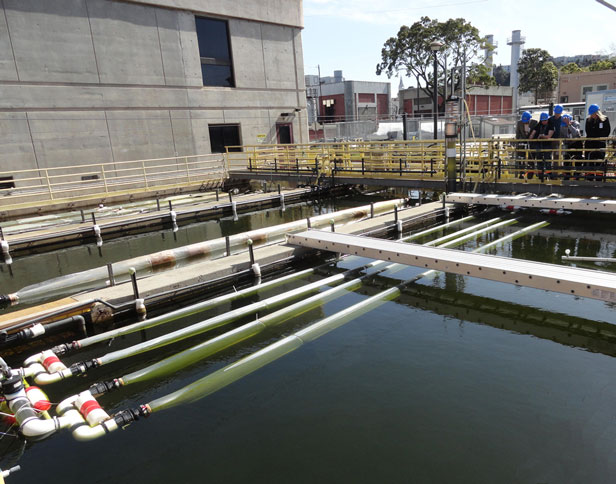NASA Wants to Launch Floating Algae Farms

Next week, NASA will show off some of its latest technology: a system for growing algae in floating plastic bags. The system is the result of a $10 million, two-year project that investigated whether the algae could be used to make biofuels, including jet fuel.
The system is designed to reduce the cost of making fuel from algae by making it possible to put algae farms near wastewater facilities, which offer a large source of nutrients.
But it may prove difficult to implement. For one thing, it will require a lot of plastic. In one possible setup, five square kilometers of plastic bags would be used to produce 2.4 million gallons of algae oil per year—a drop in the bucket compared to the 800 million gallons of oil the U.S. consumes every day. And the bags will likely need to be replaced every year.
The setup has been tested in four nine-meter-long plastic bags at a wastewater plant near San Francisco. The researchers demonstrated that they can grow enough algae to produce nearly 2,000 gallons of fuel per acre per year—if the weather cooperates. So if a commercial system gets built, it may need to be in someplace warmer and sunnier.
The lead researcher, Jonathan Trent, normally works on life-support systems for space travel. Those systems involve recycling human waste, and so does the algae fuel technology.
Trent plans to pump wastewater left over from treating sewage into bags made from common polyethylene. The wastewater is a good fertilizer, providing nutrients such as ammonia and phosphates. He also plans to pump carbon dioxide from power plants into the system to help algae grow. San Francisco produces enough wastewater to feed a floating algae farm that covers 1,200 acres, he says.
The setup is meant to solve some of the difficulties with making inexpensive fuels from algae. Algae need fertilizer to grow quickly, and wastewater is an excellent source of that. But large sources of wastewater—big cities—don’t have the space needed for the artificial ponds that algae are typically grown in. Pumping the water to areas where land is cheap and plentiful is expensive and energy-intensive. Clear containers called photobioreactors might take up less space, but those, too, are expensive.
A few years ago, Trent wondered if floating plastic bags could serve as relatively cheap bioreactors. They don’t need as much support as land-based ones—at least if they’re floating on protected bays. And they solve another major problem with conventional bioreactors, which get too hot from sitting in the sun, and require expensive cooling systems as a result. In Trent’s plastic bag system, the surrounding water helps keep the bags cool.
But while it may solve some problems—and it’s far from clear that the bags will prove superior to ponds or other photobioreactors—the system creates others. Trent acknowledges, for example, that there will be an “enormous amount of plastic” to dispose of. The plastic could be recycled, although cleaning out the algae may be difficult. A better option may be reusing it, he suggests. For example, it could be used to replace the black plastic that many farmers in California cover their fields with to reduce weeds and evaporation.
The approach will face several other challenges. Working in corrosive saltwater environments is very difficult. And it’s not clear how well the bags would survive storms.
If the bags break, the wastewater—which is normally released directly into the bay from treatment plants—wouldn’t present a problem. And the algae they would use would die in the saltwater, so there’s little threat to the bay ecosystem, Trent says. But it’s hard to predict how expensive it would be to replace bags damaged by storms or infected with competing microbes.
The researchers also don’t know how much the system will cost at a large scale. This month, they started a detailed economic analysis based on their results so far. The project also received $800,000 from the California Energy Commission.
Keep Reading
Most Popular
Large language models can do jaw-dropping things. But nobody knows exactly why.
And that's a problem. Figuring it out is one of the biggest scientific puzzles of our time and a crucial step towards controlling more powerful future models.
The problem with plug-in hybrids? Their drivers.
Plug-in hybrids are often sold as a transition to EVs, but new data from Europe shows we’re still underestimating the emissions they produce.
Google DeepMind’s new generative model makes Super Mario–like games from scratch
Genie learns how to control games by watching hours and hours of video. It could help train next-gen robots too.
How scientists traced a mysterious covid case back to six toilets
When wastewater surveillance turns into a hunt for a single infected individual, the ethics get tricky.
Stay connected
Get the latest updates from
MIT Technology Review
Discover special offers, top stories, upcoming events, and more.